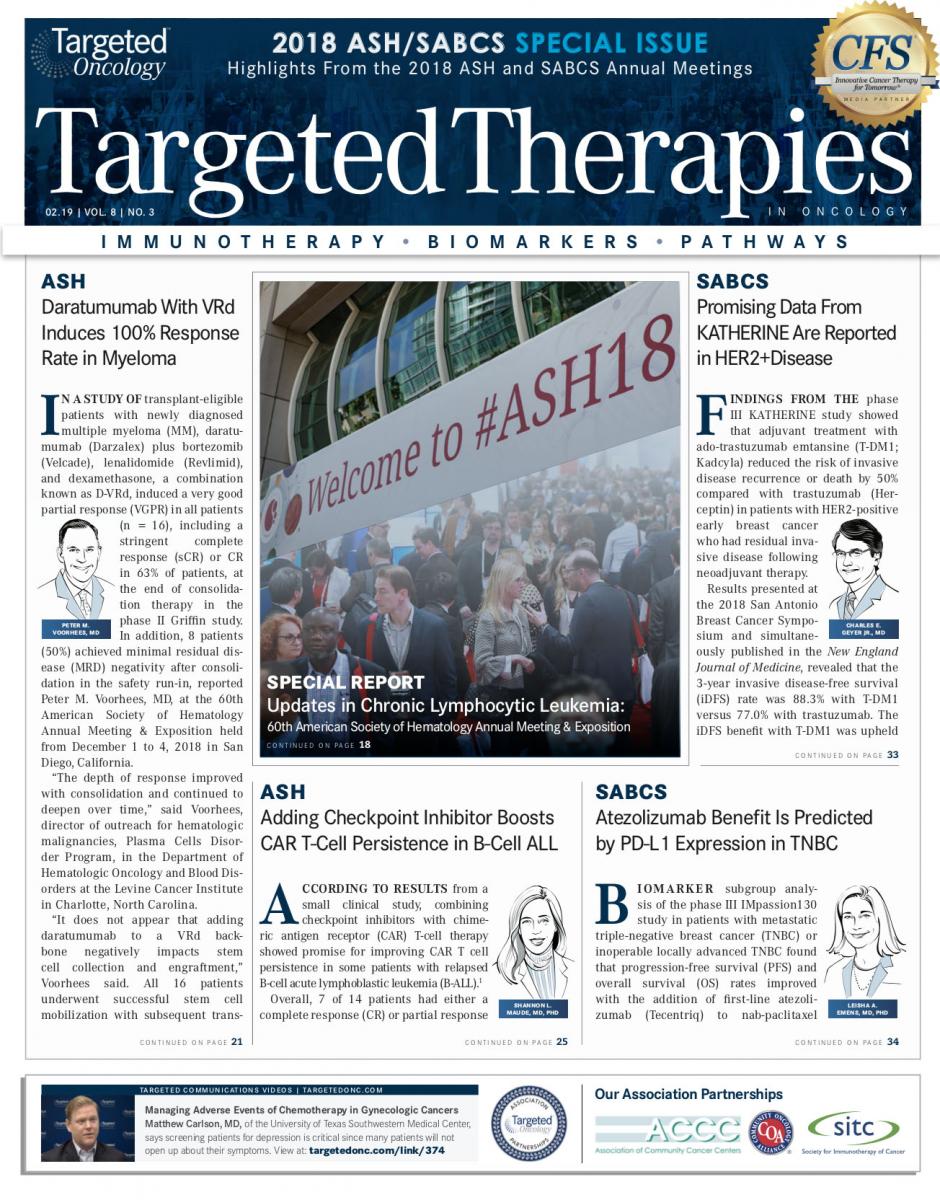Advances in Breast Cancer and Hematology Increasingly Rely on Immunotherapy
Robert L. Ferris, MD, PhD, co-physician editor in chief of Targeted Therapies in Oncology, discusses exciting new findings and merit highlights reported in this month's issue.
Robert L. Ferris, MD, PhD
A series of exciting new findings and merit highlights have been reported in this month’s issue ofTargeted Therapies in Oncology. First, the combination of immune checkpoint inhibition with chimeric antigen receptor (CAR) T-cell therapy was used in relapsed B-cell acute lymphoblastic leukemia. Overall, 7 of 14 patients showed complete or partial responses to treatment with a PD-1 inhibitor plus CD19-directed CAR T-cell therapy, as reported by Shannon L. Maude, MD, PhD, of Children’s Hospital of Philadelphia. She described these results at the 60th American Society of Hematology Annual Meeting and Exposition held from December 1 to 4, 2018. Although CAR T-cell therapy is effective for this patient population, relapses commonly occur within 12 months because of both CD19-positive and tumor-cell-escaping CD19-negative relapses. Maude and her team investigated the use of pembrolizumab (Keytruda) or nivolumab (Opdivo) in 14 patients, 6 of whom had poor persistence of response and 4 of whom had bulky extramedullary disease. Adverse events (AEs) were manageable and included mild cytokine release syndrome and fever, frequently seen with CAR T-cell responsiveness, and occasional pancreatitis, hypothyroidism, and other inflammatory conditions. There were 4 cases of grade 3/4 cytopenia. Although 2 patients had to discontinue the PD-1 inhibitor because of delayed AEs, in general, this combination was found to be feasible and showed promising clinical activity.
A watershed clinical trial was reported at the 2018 San Antonio Breast Cancer Symposium (SABCS) by Leisha A. Emens, MD, PhD, of the University of Pittsburgh Medical Center Hillman Cancer Center, detailing a biomarker subgroup analysis of the phase III IMpassion130 study in patients with metastatic or locally advanced, inoperable triplenegative breast cancer (TNBC). In the study, progression-free survival (PFS) and overall survival (OS) were improved with the addition of atezolizumab (Tecentriq) as a first-line treatment to nab-paclitaxel (Abraxane), but only in the subset of patients with PD-L1 expression ≥1% in immune cells. Because of the large number of potentially eligible patients, these biomarker analyses greatly affect clinical practice and physicians’ decision making. Emens performed exploratory analyses of other biomarkers including PD-L1 expression on tumor cells, intratumoral CD8-positive T cells, as well as BRCA1/2 mutational status, demonstrating the importance of PD-L1 expression on immune cells and predicting clinical benefit from atezolizumab plus nab-paclitaxel. These data support the routine testing of PD-L1 immune cell status to help oncologists determine whether patients might benefit from atezolizumab plus nab-paclitaxel. Among the subgroup with PD-L1–negative immune cells, the median PFS was 5.6 months in both treatment arms. However, for those 41% of patients who had PD-L1 expressed on tumor-infiltrating lymphocytes, the median OS was 25 months in the atezolizumab/nab-paclitaxel chemotherapy group compared with 15.5 months in those who received nab-paclitaxel alone (HR, 0.62; 95% CI, 0.45-0.86; P = .0035). These results indicate that immunotherapy for TNBC is here and may be effectively combined with taxane-based chemotherapy, paving the way for novel and innovative regimens as well as supporting the use of biomarker studies, as Emens so elegantly presented.
Another promising finding at SABCS, with simultaneous publication in the New England Journal of Medicine, was of the phase III KATHERINE study using adjuvant ado-trastuzumab emtansine (Kadcyla). Treatment with ado-trastuzumab reduced invasive breast cancer recurrence or death by 50% compared with trastuzumab (Herceptin) in patients with HER2-positive early breast cancer who had residual disease after neoadjuvant therapy. These data were presented by Charles E. Geyer Jr, MD, of the Virginia Commonwealth University School of Medicine, who concluded that the results present a “statistically significant and clinically meaningful improvement in invasive disease-free survival” over standard-of-care trastuzumab alone (see page 33). This large trial enrolled patients after neoadjuvant chemotherapy containing a taxane alone or with anthracycline and at least 9 weeks of trastuzumab. With a roughly 1:1 randomization, the safety analysis indicated that the majority of AEs were grade 1/2, with milder symptoms. Grade 3 AEs or greater occurred in slightly more patients (25.7% vs 15.4%) with ado-trastuzumab, and AE-related discontinuations occurred in 18% of patients in the experimental arm versus 2.1% in the control arm. Given that ado-trastuzumab induced a 50% reduction in risk of recurrence versus trastuzumab, it is very unlikely that the antibody pertuzumab (Perjeta) would have that much benefit over trastuzumab as a current standard in such a high-risk popu- lation, with an impact on the most appropriate adjuvant therapy for those with residual disease after neoadjuvant chemotherapy.
